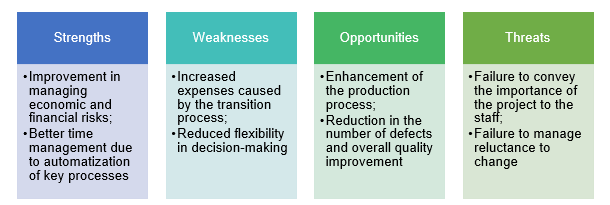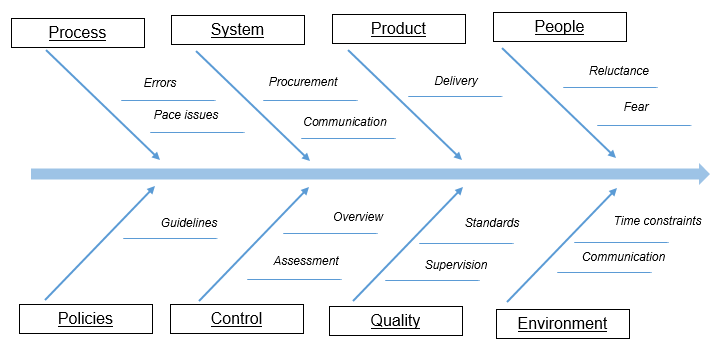Time pressure and the increased number of responsibilities and issues to control may cause a serious reduction in the quality of the end product. Therefore, for a project to be successfully implemented, the introduction of task management software is essential.
However, the designated change is fraught with multiple issues in an array f domains of the company’s performance. Specifically, the issues such as the human resource management (HRM), financial expenses, organizational processes, and quality control need to be addressed as the key areas of concern. Multiple risk assessment tools can be used to evaluate the problem with the greatest precision possible. However, the application of the root cause analysis and the SWOT matrix seem to provide the best overview of the situation and introduce the organization to the existing array of solutions.
Risk Identification Techniques
SWOT

As shown in Figure 1, the SWOT analysis allows arranging the key aspects of the proposed change into four major categories. As a result, one can see the benefits and problems of using multitasking software, as well as the opportunities and threats that the proposed change entails. Being succinct and accurate, the SWOT analysis suits the needs of the target project perfectly since it helps to evaluate key changes to the context of the project. Indeed, the application of the SWOT technique is quite common in evaluating the risk faced by organizations during project management. For instance, the SWOT framework was used to analyze the challenges encountered by Apple, Inc. in a recent study (Khan, Alam, & Alam, 2015). Thus, the application of the selected approach is fully justified.
Root Cause Analysis

Another important technique, the root cause analysis and the use of the fishbone diagram help to differentiate between the existing risks. The described framework allows focusing on the cause-and-effect relationships of change management, gauging the challenges that the organization will experience. At the same time, the root cause analysis allows establishing causative connections between key factors and respective changes, which is very helpful in examining various effects of task management software. The root cause analysis has been used widely in recent studies to explore causality in organizational issues, as the Toyota case proves (Chiarini, Baccarani, & Mascherpa, 2018).
Thus, the incorporation of the root cause analysis is essential for the project in question. Specifically, it points to the issues associated with errors made by the staff in the course of learning, increased costs, necessity to enhance quality control, and very likely reluctance among staff members.
Probability and Impact Matrix
The integration of the Probability and Impact Matrix, in turn, will help to measure the outcomes of the changes brought to the project by integrating time management software into it. While the proposed tool also allows assessing the extent to which alterations in task management will affect the project, it lacks the depth and detail that the SWOT analysis and the fishbone diagram provide. Therefore, the probability and Impact Matrix will be dropped from the list of the most effective risk assessment practices for the project in question. As the Risk Matrix in the table below shows, the project currently faces several challenges in the area of staff education and especially the response that the target demographic will provide when presented with the necessity to acquire new competencies.
Quality Assurance and Control Plan
Based on the outcomes of the analysis, meeting the risks associated with the introduction of the task management software into the environment of the organization will require changes in several critical areas. The issue of quality assurance has proven to be one of the most problematic aspects of managing the introduction of task management software into the target environment. Due to the expected difficulties in promoting employee engagement among the participants and encouraging them to accept changes, a rigid system of quality management and project supervision will be required.
To maintain the desirable quality levels, one will need to integrate the principles of the Total Quality Management (TQM) into the organizational setting. The described tool allows embracing communication issues, customer and employee satisfaction, the notion of the continuous improvement, employee and employer engagement, and strategic thinking (Gomes, Small, & Yasin, 2019). As a result, the project in question will be managed with the close focus on every aspect of performance, including SCM, HRM, communication, staff education, and strategic, fact-based decision-making.
The use of the TQM principles may be combined with the application of the Six Sigma framework as the tool for introducing change as an inseparable principle of the corporate philosophy into the organizational setting (Gomes et al., 2019). The application of the Define, Measure, Analyze, Improve, and Control (DMAIC) approach will assist staff members in getting used to task management software and encourage them to transfer to an innovation-driven system of decision-making.
Similarly, exerting control over the promotion of task management software as the tool for enhancing workplace processes is bound to be quite difficult. To institutionalize change and exert control over the project management process, one will need a control plan based on the idea of the continuous change. The acceptance of the philosophy of improvement and the active use of task management software by staff members are the key project deliverables in the case under analysis.
The quality criteria include the time consumed for task management, the efficacy of staff education (first deliverable), the quality of the output delivered by the team, and the acceptance of the new philosophy (second deliverable). The reduction of time taken to deliver the expected results and the drop in the number of errors made in the process are the key quality control tasks. To meet the set criteria, one will need to deploy supervision of workplace processes, product tests, and daily reports as the quality assurance techniques.
Action Plan
References
Chiarini, A., Baccarani, C., & Mascherpa, V. (2018). Lean production, Toyota Production System and Kaizen philosophy: A conceptual analysis from the perspective of Zen Buddhism. The TQM Journal, 30(4), 425-438.
Gomes, C. F., Small, M. H., & Yasin, M. M. (2019). Towards excellence in managing the public-sector project cycle: A TQM context. International Journal of Public Sector Management, 32(2), 207-228.
Khan, U. A., Alam, M. N., & Alam, S. (2015). A critical analysis of internal and external environment of Apple Inc. International Journal of Economics, Commerce and Management, 3(6), 955-961.